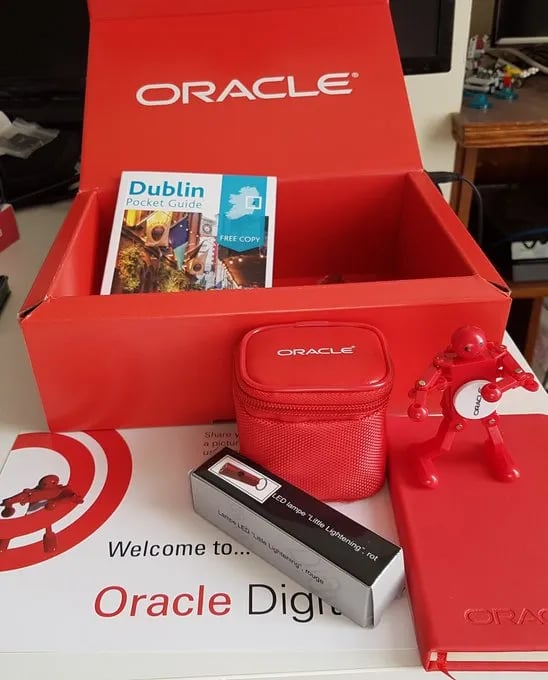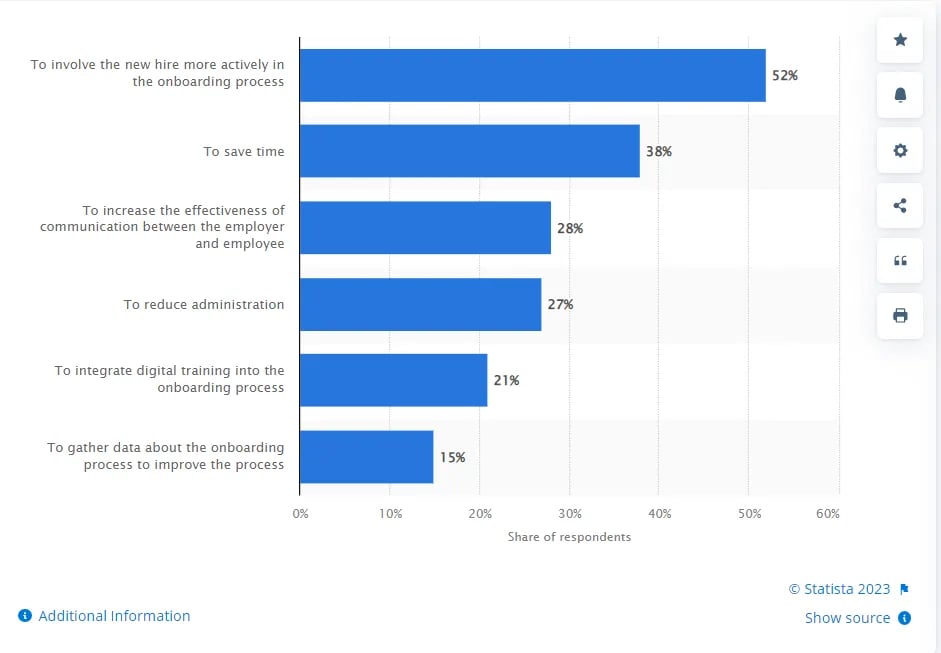Attracting and retaining high-quality talent in any organization starts with sourcing the right candidate.
However, HR professionals have to deal with a lot on their plate—from shortlisting profiles and mapping the right person to the right job to assessing candidates and driving seamless onboarding.
Once the right candidate is shortlisted, the process of onboarding begins. In fact, as per Statista, 52% of recruiters believe that "leveraging technology would empower new hires to be more active in their own onboarding experience."
To that end, in this article, we have rounded up a comprehensive developer onboarding checklist and elaborated on developer onboarding best practices to help recruiters:
- Onboard developers with a streamlined process in place
- Streamline the onboarding process for remote employees
- Improve the onboarding experience of candidates and boost engagement
- Improve the confidence of the onboarded candidate
Let's get to it right away.
An Exhaustive Developer Onboarding Checklist
If companies wish to retain good talent, they need to laser-focus on the onboarding experience. Here's an exhaustive onboarding checklist recruiters can use (and make their own):
A. Pre-Onboarding Checklist: For an Organized New Developer Onboarding Process
To eliminate guesswork on the candidate's part and remove undue stress, smart recruitment managers tackle administrative tasks well in advance.
To help the new hire onboard without breaking a sweat, get the onboarding process started before Day 1.
Start ticking off the following items from your software developer onboarding checklist:
1. Record the Information
The first task is the dreaded paperwork.
To prevent employees from getting overwhelmed on Day 1, ask them to fill out all the important information needed before they join.
You can email the documents and give them a head start. This includes employment forms, verifications, benefits enrollment documents, and company-specific paperwork.
2. Complete the Paperwork
Last-minute scrambling for missing paperwork is not ideal for the candidate or the hiring manager. That said, not all the paperwork can be completed electronically or before the first day.
So, make sure to keep the additional paperwork ready for the new hire on Day 1.
Since the employee has already tackled the bulk of the paperwork beforehand, this should not take a toll on their enthusiasm on the first day.
|
Wondering how to reduce costs and time to hire for niche roles? Try iMocha! |
3. Explain the Company Policies, Culture, and Values
To make the most of the pre-onboarding phase, recruiters can introduce the new hire to the company culture by:
- Demonstrating the "personality" of the organization via fun 'behind-the-scenes' videos; if the organization has a dedicated YouTube channel or an Instagram handle, make sure to share the links.
- Share the company's values, goals, policies, and practices through leadership 'all-hands' video meetings, presentations, and blogs.
- Creating an internal knowledge base with step-by-step instructions comprising a digital employee handbook (if any), contact information, tool guides, software tutorials, common bugs, and more.
Pro tip: To get the developer excited and charged, recruiters can schedule a one-on-one meeting with someone from the company's leadership. This will motivate the employee and make them feel appreciated.
4. Welcome the New Developer by Sending a Personalized Welcome-Kit
A personalized welcome kit has become another industry standard for most IT companies. Why? Because it creates a greater sense of belonging for the developer.
The best part? There's plenty recruiters can experiment with:
- Add branded merchandise, such as personalized mugs, t-shirts, hoodies, notebooks, headphones, laptop sleeves, etc., to add character to the welcome kit.
- Add a handwritten welcome note from the CEO for a human touch, particularly if the employee is working remotely.
- Add a team culture handbook and an employee handbook.

An Example of Oracle's 'Start Kit'
5. Set Up the Tools for Work + Communication
Providing equipment is an industry-standard in the software sector.
Whether you have in-house new hires or remote workers, you must order the tools and software in advance, as delivery takes time. Plus, recruiters can eliminate the chances of out-of-stock hardware.
When ordering the tools, make sure to:
- Cross-check the compatibility of the computer components
- Compare prices
- Contact the retailer
- Place an order as soon as the software developer confirms their joining date
A little strategic planning goes a long way in avoiding the embarrassing instance of "get-your-own-device," which makes the company look unprofessional and unorganized.
6. Give Access to the Tools and Software
Once the tools and software are sorted, it's time to provide access to the tools. Follow these steps:
- Create a company account and provide them with the login details.
- Install the IDE your developer will likely use.
- Send invitations to access the organization's project management systems, communication and chat apps, learning management systems, task management tools, etc.
- Once the apps (such as Gmail, Slack, GitHub, Asana, Jira, and more) and environments are set up, create accounts for them.
- Share links to an internal knowledge base (if applicable) that outlines the work processes.
By making the how-to steps easily accessible and getting the technical stuff out of the way, the new developer will be able to get started without worrying too much about the technical setup.
B. First-Day Checklist:
The first day is important for setting the right expectations and creating a positive impression on the new hire. To do this, the HR manager must focus on familiarizing the candidate with the team.
7. Introduce the New Hire to the Team
To get things started on the right note, introduce the new hire to the other team members either in-person or remotely.
Since someone or the other is always working-from-home, you can introduce the new hire using conferencing tools such as Meet, Zoom, etc.
During the call, talk about the following areas:
- The tasks they need to complete during the first few weeks
- The normal working hours of the team
- Have the team members quickly introduce themselves
- Talk about the company's coding standards and the expectations from the new hire
- Provide a sneak peek into the communication, collaboration, and project management tools the developer will be using
- Ask if the new hire has any questions
Pro tip: Give the new hire a tour of the company (either virtually or in-person), which includes important pit stops such as the new hire’s desk, conference room, break room, cafeteria, and the emergency exists.
8. Introduce Them to the Other Teams As Well
Take the introduction one step ahead by introducing the team member to other teams. Recruiters don't need to schedule another full-fledged meeting.
A simple introduction within a #general Slack channel works swimmingly.
Pro tip: To make things more fun, add information such as where the developer was born, what they like to do in their free time, what their interests are outside of work, and so on. They can also talk about any learning as well as technical challenges they faced in their career.
A Welcome Message from ImageX Consulting on the Company's Instagram Channel
9. Schedule the Product Training
It is impractical to expect the developer to start writing the code immediately. This is why recruiters must use an automated tool to schedule product training.
This training must:
- Include all the development tools the developers will be using in their day-to-day work.
- Allow developers to browse through the tool and familiarize themselves with the new dev environment.
- Talk about how and why each tool is used.
Pro tip: Product training must also include important topics such as the direction in which the product is heading, what the company's engineering infrastructure is like, and how the internal processes take place. Make sure to spread the product training over a week to avoid burnout or information overload.
C. First Week Checklist:
As the new hire's adrenaline wears off, they will start having questions on the work front. This is the time for recruiters to share critical product-related information and share technical documentation with the new hire.
10. Introduce the Product
The importance of sharing the organization's product information and structure cannot be emphasized enough. Newly-joined developers need to have a better understanding of the product to be able to innovate or improve it further.
The product induction training and workshop can help new hires to:
- Get enough time to set up their own working environment
- Get a glimpse of the technical developments within the company
- Understand the codebase and the code style the teams use
- Work on real bugs and make fixes and gain confidence in the process
Pro tip: Team leaders must provide developers with application or product-specific problem sets to get a better sense of the organization's problems. Also, it is important to keep the product information concise and to the point.
11. Share Technical Documentation
As an extension of the previous point, hiring managers must also share relevant technical documentation that the new hires may need. The idea is to make the information centrally accessible anytime, anywhere.
Some of the most important examples of software documentation include:
- Work process documentation
- System documentation
- User documentation
- Project and product documentation
The hiring managers can also make things more interesting by lining up tech talks, hands-on workshops, and tech conferences for the new hire to attend.
For example, Shopify leverages the idea of a Code Lab—a meetup where people talk about the step-by-step walkthrough of a problem, technology, or service. Here's how it works:
Step 1: It is done independently or as a group.
Step 2: Via this initiative, new hires can:
- Understand the Shopify codebase
- Learn more about the product
- Understand the on-the-job requirements (think: pulling a code review process, understanding how to navigate the codebase, setting up a Shopify store, writing tests at Shopify, and so on)
One of the Code Labs at Shopify walked the new hires through shipit—the brand's internal deployment tool. This helped the developers ship code into production—on the very first day with the team!
The end goal is for the new hire to completely immerse themselves into the way the company works and, more importantly, how it develops products.
Pro tip: Get the organization's engineering management (think: Directors of Engineering, technical leads, CTO, etc.) to conduct town halls or workshops for the new hires. This will help keep them motivated.
12. Share a Small, Non-Complex Task
Once the product training is complete, and the technical documentation has been shared, hiring managers can give the developer small, non-essential tasks to assess their knowledge.
iMocha's coding simulator empowers recruitment managers to assess a candidate's analytical thinking and problem-solving capabilities and understand the logical approach of coders in addition to assessing their coding abilities.
Fun tasks like these will keep the developer busy and reduce internal stress as well as anxiety. Plus, the developers can get a more hands-on experience of what's expected from the company in terms of development quality and issues faced.
If you want to assess the skills of developers comprehensively, then you should consider using these developer assessment tools.
|
Wondering how to deduce project readiness of candidates? Try iMocha's Project based assessments! |
13. Arrange Daily/Weekly Meetings with the Tech Team
To ensure that the new hire is fitting well into the larger scheme of things, it is important to schedule daily/weekly meetings with the tech team. These check-ins can help the new developer:
- Sync up with the work that is being done, understand what the requirements are for the day, and get a better understanding of the state of the project.
- Stay up-to-date with everything that's happening and feel more connected and engaged with the team.
Pro tip: Hiring managers must also assign a buddy (or a knowledgeable mentor) so that the buddy can offer useful advice and tips on any problems that the new hire may be facing. Other responsibilities of a buddy include:
- Helping the new hire get acquainted with the company's cultural rules and norms
- Improving social connections
- Ensuring knowledge transfer
- Demonstrating the organization's ins and outs
According to research, the buddy system can "accelerate the productivity of new hires and enhance job satisfaction, making it easier for employers to retain individuals."
D. First Month Checklist:
14. Arrange One-on-One Calls with the Reporting Manager
One-on-one video meetings with the manager are a powerful way to enhance relationship-building and build trust as well as transparency. It empowers the new hire to feel included and respected within the organization.
Moreover, both the managers and developers can take this opportunity to iron out any issues, celebrate the key milestones, and understand what's working for them (and what's not).
Pro tip: Other important topic areas to include are code quality, job satisfaction, end-goals, future plans, work-life balance, and motivation while engaging in a one-on-one.
15. Collect Feedback on Onboarding to Improve the Hiring Experience
The onboarding process can be continuously improved. This is why it is critical for recruitment managers to keep gathering real-time feedback from the developers.
They can roll out surveys or conduct quick polls to get a sense of where the developers are at.
This will help:
- Build a relationship with the developer
- Make the developer feel valued, appreciated, and heard by the organization (quite literally)
- Allow recruiters to identify key bottlenecks within the onboarding process, particularly when it comes to remote onboarding
Pro tip: If the developer's ideas/suggestions have been taken into account, make sure to communicate the same to them. Follow-up is as important as gathering feedback itself!
The Final Word
There you go. As you can see, a well-conceived and useful developer onboarding checklist starts before Day 1 and extends well into the first few weeks.
Since there are multiple moving parts to take care of, having an automated tool to assess the right candidate in the beginning can take off the workload from overworked hiring managers.
This is where iMocha can assist hiring managers in assessing candidates for accurate and relevant technical skills.
If you want to onboard the best job-fit candidates by assessing the important communication skills, technical skills, and other skills, iMocha is worth a shot.
|
What's common between TCS, Capgemini, and Fujitsu? They all trust iMocha with their skill intelligence needs. |
FAQs
How to onboard new developers?
If you are looking for a checklist on the software engineer onboarding process, keep reading. Here are some tips on how to onboard new developers without any friction:
- Get the new developer to start on the paperwork from Day 0
- Welcome the new developer on zoom or in-person
- Acclimatize the new developer with respect to the company culture, values, and policies
- Work out the logistics relating to the tools, hardware, and software needed
- Provide the login credentials and offer access to the communication, project management, and task management tools that the organization uses so that they can perform their job easily
- Create a personalized welcome kit and make it creative as well as fun!
- Share a new hire announcement on collaborative channels such as Slack or via email
There are many ways to facilitate a smooth new developer onboarding process. Recruiters need to take inspiration from the ideas outlined here and create a custom recruitment strategy.
|
Wondering how to identify critical skills for organizational growth? Talk to our experts to learn how we enable Capgemini, Cognizant, TCS, Fujitsu and other global organizations to do so! |


-63bfb4c11b5af.webp?width=465&height=800&name=screenshot_(1191)-63bfb4c11b5af.webp)
